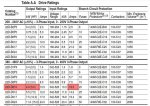You must understand that the INPUT info in this chart is all about conformance to regulations regarding specific terms, i.e. "Maximum Input Amps", but then the OUTPUT is based on the CAPACITY of the devices, not the motor FLC. In most cases the motor FLC on the nameplate of a given motor in the stated HP range SHOULD fall within the maximum output amp ratings, but in several places, AB warns you (as ALL VFD mfrs do) to NOT use HP as a final value, you MUST use the motor NAMEPLATE FLC. That chart just means that under the WORST case scenario, being a 342V input, and controlling a maximum motor amp output current the transistors are rated to safely deliver, being 10.5A, the maximum input current will not be any more than 13.0A. That does NOT mean that the input current WILL be 13.0A under all conditions, i.e. 480V input.
The way Article 430.122 is worded, you MUST size the conductors based on that Maximum Amp rating, which is why the chart is worded that way. This is because regardless of what you may be connecting to the drive now, someone in the future may read the nameplate on the drive and go for the maximum. Requiring the conductors to be sized for the DRIVE maximum current ensures they will always be adequate.
Typically though, you size the conductors per the rules, then size the breaker to protect the conductors and per the breaker rules. All modern VFDs are now required by UL* to provide ALL of the motor branch circuit protection for each single motor below it, satisfying 430.53 (C). So once that is satisfied, your multiple drives application falls under the rest of the normal rules for 430.53.
By the way, you mentioned using an MCP, by which I assume you mean an "Instantaneous Trip" (Magnetic Only) Circuit Breaker. You cannot use those. Even VFD mfrs can no longer use them on VFDs, even when assembled by the factory. It used to be OK, UL recently changed their minds. But that was NEVER the case with regard to field assembly.
*UL listings for VFDs as "Motor Controllers" require this. There are cheap bottom feeder drives that still get away with calling their products "Power Converters" and UL listing them like they do for solar inverters, which gets around the need for having to provide motor protection. You can always tell if they did that by either looking at the label itself, or look at the installation instructions. If they say that YOU must provide motor branch short circuit and OL protection, you have been had...

